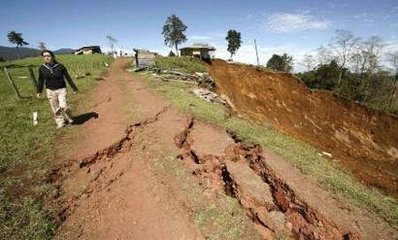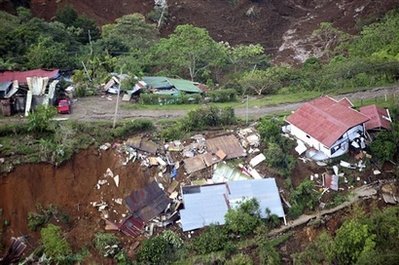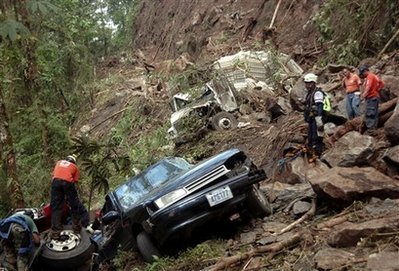11 January 2009
Costa Rica earthquake – landslides have proven to be a major threat
Posted by Dave Petley
News continues to flow in regarding the impact of the earthquake in Costa Rica. It is increasingly evident that landslides have probably been the major problem, which is unsurprising given the topography and soils. The landslides have clearly caused substantial loss of life and are also hampering rescue operations.
The Washington Post is reporting, quite rightly, that there are now concerns about the stability of the slopes in the affected area in the next wet season. The Reuters image below shows seriously deformed ground above the crown of a seismically-triggered landslide at San Rafael de Vara Blanca:

I found the diagram below showing rainfall in San Jose, which is just a few tens of kilometres away:

Fortunately the period January to April is pretty dry, but problems will certainly start in May. Action will be needed to address this as the level of hazard will be high in many areas. At the moment the biggest problems seem to be around the village of Cinchona, on the flank of the volcano, were a family restaurant was buried (see AP images below of Cinchona):


There are certainly lots of other landslides too, as this AP image shows:

Finally, the Washington Post is carrying a slightly intriguing report:
“A wave caused by the earthquake damaged the Cariblanco hydroelectric plant and it will take at least a year to repair, local media quote a senior official as saying.”
A bit of digging shows that AP are reporting that “Officials reported meanwhile that the country’s leading Cariblanco hydroelectric plant will be out of operation for about a year, after its generators were buried by tons of mud from flooding and landslides unleashed by the earthquake.”
According to this site, Cariblanco appears to consist of two 40 MW turbines. It came into operation in 2007 after construction costs of US$170 million. This would appear to be a very expensive set of landslides for such a new project! Unfortunately, our experience elsewhere (e.g. Taiwan) is that sediment delivery increases in the rainy season as further landslides activate, so the operators of this site would be well advised to get some landslide advice.


 Dave Petley is the Vice-Chancellor of the University of Hull in the United Kingdom. His blog provides commentary and analysis of landslide events occurring worldwide, including the landslides themselves, latest research, and conferences and meetings.
Dave Petley is the Vice-Chancellor of the University of Hull in the United Kingdom. His blog provides commentary and analysis of landslide events occurring worldwide, including the landslides themselves, latest research, and conferences and meetings.
Here’s an account of the damage, from Tiquicia’s BlogCosta Rica News by Tiquicia’s Homepage official blog“On Friday afternoon, 1,600 households were still without electricity, after the Costa Rican Electricity Institute (ICE) restored power to 11,700 homes. Power will not be restored to Cinchona for another three weeks because ICE may have to build new posts and cables, said ICE’s Jesus Sanchez. Two cell phone towers near the quake’s epicenter were still down Friday evening.The quake’s casualties also include the Cariblanco hydroelectric power plant at San Miguel de Sarapiqui in north-central Costa Rica. The plant is full of mud and branches and will be shut down for a year, said ICE president Pedro Pablo Quiros.”
more re the Coasta Rica power situation; this looks like a country where loss of hydro power is a bigger problem.Costa Rica faces blackouts daily in 2009 San Jose, Costa Rica(AP) — Pedro Pablo Quirós, president of the Instituto Costarricense de Electricidad (ICE), said yesterday that the institution does not have sufficient funds to purchase fuel to generate sufficient electrical energy and that ICE engineers will be begin tomorrow to program a blackout schedule for 2009. Quirós explained that the engineers are expected to define how many hours a day and the areas where electrical service will be suspended. Quirós predicts 2009 a catastrophic year for the institution and the country.
I am a grad student from the University of Maryland (UMBC campus) in geography and environmental systems. I am conducting research on Costa Rican landslides with plans to focus on the province of Cartago and the 400KM2 canton of Paraiso, where I live part of the year (including eight weeks of this summer). I am particularly interested in working on a landslide inventory of this Canton and learning more about the soil and hillslope hydrology of this area since I think this has been understudied in neotropical areas. Please send me an email if you would like to talk or offer advice. This is my second career after about thirty years as a Univeristy-based physician in Chicago and Baltimore. Thanks Judy [email protected]
As always an excellent posting.Theway you write is awesome.Thanks. Adding more information will be more useful. Bathmate
As always an excellent posting.Theway you write is awesome.Thanks. Adding more information will be more useful. Bathmate
Well sounds bad but I would like to move to Costa Rica, but first I need to find a lot and learn a little Spanish.
guanacaste costa rica real estate